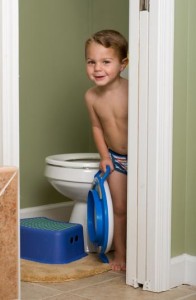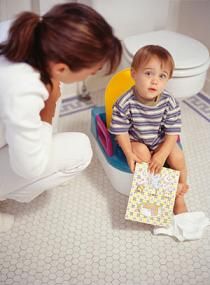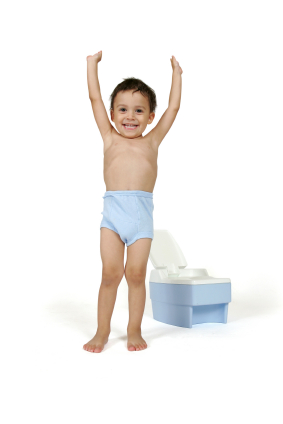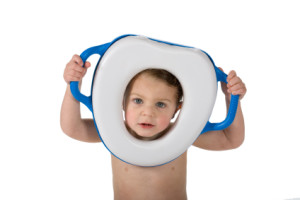Many parents dread the potty training process because they have heard that little boys have poor aim and make a lot of messes when they first start learning. While you have to expect some accidents during the toilet training process, effective parental guidance can take the hassle out of potty training a boy to use the restroom without making a mess.
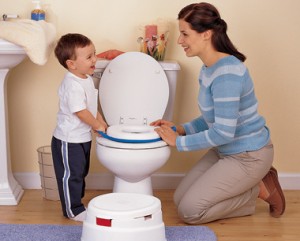 If you can show your little boy what you expect of him and introduce him to the tools he can use to meet those expectations, he is likely to be potty trained quickly without tons of messes. The first step is to create a clear procedure for training. From there, you can introduce this procedure to the child in an understandable manner. The following tips will help you do that effectively.
If you can show your little boy what you expect of him and introduce him to the tools he can use to meet those expectations, he is likely to be potty trained quickly without tons of messes. The first step is to create a clear procedure for training. From there, you can introduce this procedure to the child in an understandable manner. The following tips will help you do that effectively.
Role Model Proper Behaviors
The easiest way to show a child what you want them to do in the bathroom is to let them see the desired behavior in action. If you have an older boy in the family who is already potty trained, he will likely volunteer quite eagerly to become the role model. The boy’s father could also become a role model for proper potty procedure. Ideally, mothers and sisters will only role model for little girls, but that may not always be possible.
It is understandable if the father or older brother of your little man is a bit gun shy when it comes to being watched in the bathroom. Reason with them that this is their child, grandson or otherwise a close relative, and they are only watching because they need to learn quickly. Most men and boys can get over their discomfort long enough to help out.
Does your little guy have a friend who is already potty trained? It may motivate your child to potty train faster if they watch their friend doing it. Peer pressure is not always a bad thing, right?
Recognizing Wetness
Every little boy must recognize the difference between three stages of wetness before they can effectively potty train:
- About to wet
- In the wetting process
- Already wet
Starting out, most little boys will only acknowledge wetness after they are soaked in urine. Your job as a parent or guardian is to help him identify the sensation that comes before he actually urinates. This is done by paying attention to the child’s behaviors immediately before he pees his diaper or has an accident.
For example, you may notice that your little boy stops playing or makes a funny face just before using the bathroom in his pants. You can stop him at that exact moment and help him to understand that the sensation he feels right then signals that he is about to use the bathroom.
Putting a name on the action of using the bathroom is more effective when potty training a boy than asking general questions. For example, many parents notice that a child is pooping and say, “What are you doing?” It is more effective to say, “You are pooping now. Do you see how that feels?”
Naked Training Times
Whenever your boy can run naked for the sake of potty training, allow it. This allows him to sit directly on the potty when needed without taking the time to pull down pants and underwear. It also makes it far easier for him to see what his body is doing and how that correlates to how he feels before, during and after a potty session.
This method of potty training may lead to accidents, so make sure you have carpet cleaner on hand. You can also set your child’s potty on tile or linoleum bathroom floors so it is easier to clean up any mistakes. Make sure you do not scold or shame him for these mishaps since they are an expected part of the potty training process.
Identify Correct Locations for Potty Breaks
Start changing your child’s diaper in the bathroom and place the plastic potty next to the big potty in the bathroom. You want your boy to identify the proper place for using the bathroom so that they start to use it in inappropriate places less frequently. Little boys two-years-old and older do not need to be changed on a changing table, so make full use of your restrooms.
Naming Activities
You can use exact terms for “pooping” and “peeing” that come naturally to your child, but make sure that you are using specific terms. For example, “using the bathroom” or “going potty” is far too general to help your child identify what he is doing. Go with “peeing” and other terms that identify specific behaviors.
Avoid terms like “stinky” because you don’t want your little boy to think of using the bathroom as a negative activity. This is a natural part of being human, and they should not feel embarrassed about it.
Open Discussion about Potty Behaviors
Start conversations with your child about the wonderful things that come along with potty training. You may tell him that he can spend more time playing once he is potty trained since he won’t have to stop for long diaper-changing sessions. You can tell him that he will feel more comfortable when he doesn’t have to wear a diaper, and diaper rash will no longer bother him.
Listen to your child’s response to these ideas. If he is big enough to comprehend what potty training is, he will have ideas and thoughts on the process. Make sure to answer all questions he has in a positive light.
Pull-Up Dress-Up
If your son is interested in playing dress-up with his pull-ups, let him do it all he wants. This practice will make him more comfortable with the potty training process and may get him excited to use the bathroom and get rid of his diapers. Get to the store and let him pick out his own big boy underwear and talk to him about not getting them dirty or wet so he can wear them longer.
 Potty Chair Play
Potty Chair Play
Set out a small potty chair and give your child permission to sit on it whenever he wants. He may read books or play with toys while sitting there, even if he does have clothing on. The goal is to make him comfortable and familiar with all equipment used to use the restroom. Even if it becomes his favorite toy and he drags it all over the house, at least he is getting used to the idea of sitting on it.
Your child may also enjoy setting dolls on the potty and pretending they are using the bathroom. He may have a special doll or bear that is used only for this purpose so that it feels like a special toy.
You may also let him flush the toilet when you are in the bathroom to supervise. Talk about his poop and pee hitting the water, and allow him to wave bye as he flushes. He will get used to the sound and may get so excited about flushing that he wants to use the potty faster.
When you feel he is ready, you can start explaining how he should pull down his pants and use the potty for real. Explain where the poop and pee must go and how he must relax his body to let it leave. His reward is getting to flush and watch it disappear.
Celebrations and Excitement
Throw a party to get rid of your son’s diapers. Wrap up underwear with characters or pictures that he will like and let him open them while you are excited and happy. Whenever he makes a step toward being potty trained, throw little celebrations and shower him with hugs and kisses. Tell him how proud you are of him. The more positive attention he gets from you, the better.
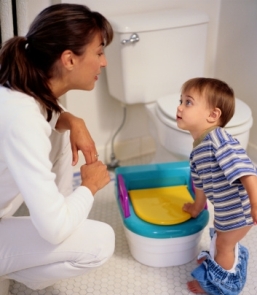 There are many silly moments which naturally surface when potty training boys. There are also some aggravations and trying times that you will only laugh about after you have finished potty training every little boy in your home. Your little baby is becoming a toddler, and after that they will become a little boy, pre-teen and then a teenager. Your job is to prepare them for toddlerhood and beyond through efficient potty training lessons.
There are many silly moments which naturally surface when potty training boys. There are also some aggravations and trying times that you will only laugh about after you have finished potty training every little boy in your home. Your little baby is becoming a toddler, and after that they will become a little boy, pre-teen and then a teenager. Your job is to prepare them for toddlerhood and beyond through efficient potty training lessons. Here at PottyTraining-Boys.net we offer a collection of strategies and suggestions that have been used by other parents interested in making this process easier. You are not expected to use every tip and trick featured on this site. Some of the ideas will work for your child, and others you will rule out right away because you know your child best. The idea is to give you a variety of options so you can select the potty training resources and strategies that may work with your child’s temperament, age and abilities.
Here at PottyTraining-Boys.net we offer a collection of strategies and suggestions that have been used by other parents interested in making this process easier. You are not expected to use every tip and trick featured on this site. Some of the ideas will work for your child, and others you will rule out right away because you know your child best. The idea is to give you a variety of options so you can select the potty training resources and strategies that may work with your child’s temperament, age and abilities.